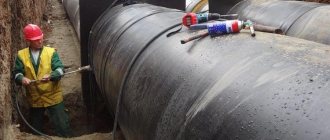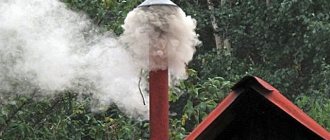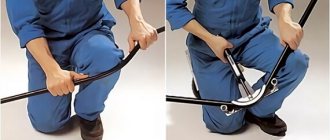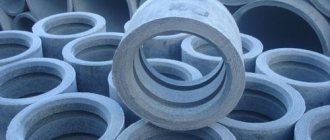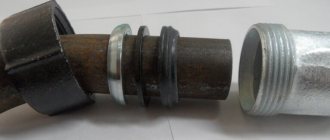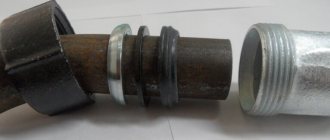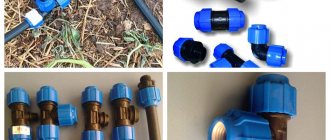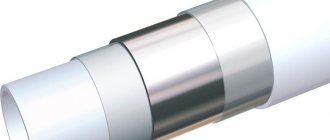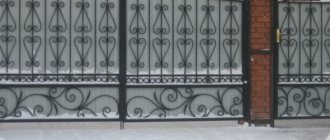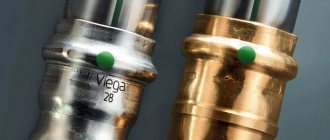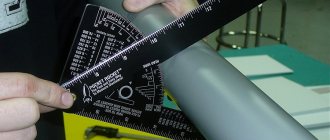TOP 3 methods
The joining method common when laying various pipelines depends on the size and mobility of the parts. There are 3 methods of manual electric arc welding of large diameter pipes:
- coated electrodes;
- electrodes in a protective gas environment;
- argon-arc.
The quality and composition of the material being joined determine the operating modes and current value:
- variable;
- constant reverse polarity;
- constant straight polarity.
Alternating current is used when welding aluminum . Pulsed feed prevents the arc and metal from heating up too much and forming burns.
Reverse polarity, when a minus is connected to the part, gives more heat and power. The metal of the pipe at the junction and the electrode heat up more strongly.
Description
Pipeline welding technology, manual arc welding, provides the best, most durable connection. To protect the seam from oxidation, flux is used - coating the electrode or a gas environment.
When current passes through a steel sheet and an electrode, an electric arc occurs at its end. It begins to warm the edges of the connected pipes and melt them. A weld pool is created from the molten metals of the parts being joined and the electrode.
A worker guides a liquid bath with an electrode, mixing metals and creating a seam. Oxides and gases rise to the surface, forming a film. The slag protects the hot weld from contact with air and sudden cooling.
Instructions
Cleaning the edges before starting processing means avoiding internal defects.
You should check their cutting angle, set and fix it in 3 – 4 places, depending on the diameter. Tack welds are made with the same brand of electrodes that will be used for root weld welding.
You should follow safety precautions: wear special clothing, check the serviceability of the equipment. Turn on the welding machine and set the operating modes.
Preparatory stage of arc welding of pipes
Let's start with the equipment needed for the work, in addition to the welding machine. The welder's workplace is called a welding station, which is equipped with tools such as:
- electrode storage box;
- electric holder;
- set of probes;
- hammer;
- chisel;
- emery;
- tin tray for cinders;
- metal brush;
- power cable for arc welding;
- set of templates;
- protective equipment (helmet, shields).
The welding cable must be flexible and have a sufficient length for the given cross-section that does not hinder the work of the welder.
The helmet and shields are designed to protect the face and especially the eyes during work. They are necessary, since the radiation generated during arc welding negatively affects the skin. The helmet is usually made of fiber or specially prepared plywood and weighs up to 600 g when finished. Amateur welders sometimes neglect such protection because, in their opinion, it interferes with their work. But this excuse is wrong, because a properly used helmet or visor should not cause any inconvenience.
A 6x12 cm cutout is made on the front side of the helmet, which is quite enough for full observation of the process. If you make your own protective shield, you should keep in mind that the sight glass must be special, not transmitting radiation in the infrared and ultraviolet ranges. On the outside, this filter can be additionally equipped with ordinary glass to protect against splashes.
We recommend articles on metalworking
- Steel grades: classification and interpretation
- Aluminum grades and areas of their application
- Defects in metal products: causes and search methods
Another important welding device is the electric holder. This tool must be mounted at any angle to protect against overheating, and must also weigh no more than 500 g. In addition, it is necessary to ensure reliable insulation of the holder from the effects of electric current. If we consider the three types of electrical holders offered on the market (pincer, fork, with a spring ring), it is better to make a choice in favor of the first.
The overall quality of welding depends on proper preparation. Therefore, before starting welding work, you should perform a number of steps, which are given below:
- Checking details.
All elements from which the welding system is assembled must be carefully inspected. Check the dimensions of each part (length, thickness, diameter), composition, and also make sure there are no defects, damage or deformations.
- Edge preparation.
The edges of the parts to be welded are first cleaned of traces of corrosion, dirt, oil and moisture. To do this, use a needle mill or a regular brush. It is also recommended to degrease the edges. In order for arc welding to be performed with the highest quality possible, the edges of the pipes are straightened with mandatory gap control. If access to the edges is difficult, use a gas burner to heat them or treat the gap with compressed air.
- Checking the bevel.
Check the bevel angle and the amount of bluntness - they should be in the ranges of 60–70 mm and 2–2.5 mm, respectively. If, after mechanical cutting, work hardening has formed on the edges, and there is also a casting skin, these defects should be removed with an emery stone.
Which is correct?
Critical sealed seams are welded in 3 passes. The root, first seam is performed with an electrode with a diameter of 3 mm. Subsequent 4 and 5 mm. For good root formation, cellulose-coated electrodes are best.
The following layers are applied according to the type of pipe. When welding the second layer, the first one must also partially melt. Then there will be no lack of penetration and slag inclusions inside the seam.
When welding high-alloy pipes, 3 layers are applied to the seam, one after the other. The temperature between them should not exceed 150⁰C.
With joint rotation
When turning the joint, the pipe is welded vertically from bottom to top. The diameter of the pipe is conventionally divided into 4 sectors. The dots are located on the watch dial at 2, 5, 7, 11. The lower and upper sections are slightly shorter than the side ones.
- The lateral verticals of the root and first seams are cooked alternately.
- The pipes are turned 90⁰, and first the section that was lower is welded, then the other. In this case, the seam is not applied end-to-end, but overlapped by 40 - 50 mm.
- The 2nd and 3rd layers are applied in the same way, but the start of welding begins with an offset of 10 - 15⁰.
When welding from bottom to top, you should change the angle of the electrode so that the bath is heated equally.
Without joint rotation
If the structure is firmly fixed and the pipe cannot be rotated, non-rotational welding is used. The seam is applied from below.
- The lowest point on the pipe is marked.
- Welding begins beyond the marking.
- From the ceiling it gradually moves to the vertical and to the top of the pipe.
- You need to start cooking the second side from the intended bottom point. This results in a slight overlap.
During repair work, it is often necessary to weld joints in hard-to-reach places. When the pipe is close to the wall and cannot be moved away.
In this case, high-quality penetration of part of the seam is made from the inside.
- A small window is cut out.
- Through the hole formed, a pipe is welded from the inside opposite the wall.
- The cut element is installed in place, tacked and welded together with the remaining open seam.
In this way, pipelines with a diameter of more than 60 mm and a wall thickness of up to 3 mm are repaired, when it is enough to put one seam.
At low temperatures
Cold metal at low temperatures does not have time to warm up and a pronounced transition zone is formed.
It has broken molecular bonds and increased fragility. If you hit a part, it will burst not at the seam, but nearby, along the base metal. To avoid destruction of the seam, the parts to be welded should be heated .
The best option is to place them in the oven and heat them to 200 - 300⁰. This method is not suitable for laying pipelines. The pipe joints are heated with a gas burner, moving it evenly in a circle several times.
Technology
Electrodes are selected for the root seam 2 - 3 mm, subsequent ones are thicker. If the wall thickness is more than 12 mm, it is possible to use ANO and UONI grade rods with a thickness of 6 mm on the last layer.
Welding is performed using a DC inverter or transformer. To work in the field with large-diameter parts, rectifiers are used.
On direct current they cook with reverse polarity, applying minus to the part. Alternating current is used for aluminum, non-ferrous alloys and high-alloy steels.
The arc must be kept short, it should not touch the parts being welded, just direct the bath to the right place. Care should be taken to ensure that the slag has time to melt and float.
Parts must be cleaned of dirt and oxides. Edge cutting is not done at the enterprise when rolling products or on a machine as an afterthought.
Hedgehog education
A burr, or urchin, is a hollow formation within a seam or under a layer of spatter . The formation of hedgehogs during pipe welding is a welding defect that has a destructive effect. X-ray illumination detects internal defects, a non-destructive testing method. Most often, burr is formed when welding aluminum. It should be cooked with alternating current, in a jerky method, so that there is no overheating.
To avoid the formation of hedgehogs, you should monitor the gases formed in the bathroom; they must have time to escape. If a stop occurs, you should return 20 - 30 mm, clean the surface of slag and continue, starting to walk along the seam.
You can reduce the amount of agrate by thoroughly cleaning the edges, especially on aluminum. Then rust and dirt will not melt in the bath and contaminate the seam.
To remove tarnish colors without removing the layer with an abrasive wheel, you can use a chemical method. Inox Gel or Stain Clean etching paste is applied to the surface of the pipe. The compositions are very poisonous, you should wear a respirator and gloves and apply with a brush.
Checking the quality of arc welding of pipes
The formed weld inevitably leads to the formation of various defects in the pipe metal. Typically this occurs during the cooling or heating process. Other damage occurs due to non-compliance with welding requirements.
Emerging defects ultimately deteriorate the quality of the entire pipe, so they need to be identified and prevented in advance. We list these defects below:
- Violation of the metal structure. As a result of this flaw, a coarse-grained material is formed, and the grains along the edges are oxidized due to an increase in the oxide content.
- Increased gas content, increased porosity. Pores can form in groups, individually, or form unique bridges. Porous structures emerging on the surface of the metal are called fistulas.
- Contamination of the seam with slag. These impurities significantly reduce the initial strength.
- Formation of cracks. As a rule, they are formed near the seam and can vary in type and size.
- Lack of penetration. This word refers to local areas of the weld where there is no adhesion to the base metal.
- Burning holes in seams. Occurs as a result of leakage of molten mass from welds.
- Formation of undercuts. This is the name given to the grooves formed along the seams near the boundaries with the base metal.
- Deformation of welds.
Each of the listed defects must be identified and subsequently eliminated. Only then will it be possible to talk about the highest quality arc welding of a pipe. At the same time, the impact of each flaw on the performance of the entire pipeline is assessed. Otherwise, it will not be possible to completely eliminate the malfunction before operation.
Analysis of the quality of a pipe begins with its external inspection, both visual and using various measuring instruments. At this stage, external negative influences are identified and satisfaction with the requirements and norms of current laws is determined.
Working with gas pipelines and pipes for transporting aggressive liquids
Ceramic spacers are used to form the root seam. They are attached to the reverse side and form molten metal, preventing it from leaking out. Ceramic gaskets prevent porosity, undercuts and sagging.
Welder of the 6th category, foreman of a team of welders of equipment for the food and chemical industries Boroday N.S.: “When welding critical pipes and stainless steel containers, the formation of beads on the inside is not allowed. When laying the root weld, it is necessary to ensure that argon is blown into the welding area. If it is impossible to use argon locally, it is pumped into a container or pipe, ensuring airflow throughout the entire root weld welding with an intensity of 3 - 4 l/min. When accessing the inside of the structure to be welded, flux paste is applied to the back of the seam, diluted with alcohol to the consistency of toothpaste. It will help form an even seam and prevent the formation of aggregation – hedgehogs.”
Requirements for a weld according to GOST
The basic requirements for seam quality and control methods are set out in GOST 23118-99 . It specifies the requirements for the continuity of the seam, the absence of undercuts, tops and other defects.
GOST 5264-80 regulates the shape of the seam, its scaliness, convexity and width. On what connections, what leg should it be. He recommends equipment and tools for specific jobs based on the material.
To complete the training and begin quickly and correctly connecting parts, the technician must first study the theory. Then practice takes over. A thin sheet should be connected to another several times in a row, changing the modes and speed of the arc. After obtaining parts with a perfect convex joint, you can move on to alloy metals and non-ferrous steels. And only when the vertical and the ceiling are conquered. Start welding pipes.
Preheating
Welding work on steels with a high carbon content requires preheating of the workpieces. This is due to the tendency of the material to undergo sharp hardening.
Exposure to temperature makes the area around the seam non-ductile. Under such conditions, the seam is formed unevenly (read how to eliminate a leak in a heating pipe in this article).
Preheating the workpiece reduces the cooling rate, which makes the surface plastic for a long time.
Such zones protect products from the formation of cracks due to temperature deformation. The heating mode is calculated based on the thickness of the material and composition.
